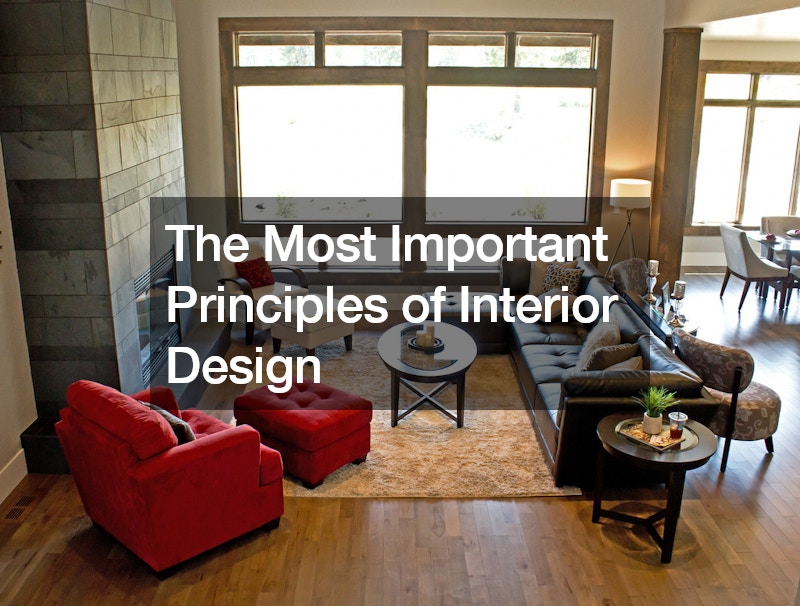

Interior design encompasses a multitude of principles that contribute to creating harmonious and functional living spaces. From the fusion of different styles to the emphasis on functionality and aesthetics, understanding the key principles of interior design is essential for crafting inviting and well-designed environments.
Harmony and Balance:
One of the fundamental principles of interior design is achieving harmony and balance within a space. This involves creating a cohesive relationship between various elements such as furniture, color schemes, textures, and decorative accents.
Whether it’s blending contrasting styles like Japandi Design or balancing minimalism with maximalism, achieving harmony and balance ensures that the space feels visually pleasing and unified.
Functionality and Purpose:
Another crucial aspect of interior design is prioritizing functionality and purpose. Spaces should not only look good but also serve their intended function effectively. Industrial design, for example, emphasizes the practicality of open floor plans and exposed materials, while Muji design focuses on maximizing space utilization and organization. By designing with functionality in mind, interior spaces become more efficient and user-friendly.
Minimalism and Simplicity:
Minimalism is a popular design approach that advocates for simplicity and decluttered spaces. By using the bare essentials and eliminating excess decoration, minimalist interiors create a sense of tranquility and serenity. This principle is evident in modern contemporary design, where clean lines, monochromatic palettes, and uncluttered spaces reign supreme. Minimalism not only promotes visual clarity but also encourages a mindful approach to consumption and living.
Texture and Materiality:
Texture plays a vital role in adding depth and visual interest to interior spaces. Whether it’s the rough texture of exposed brick in industrial design or the natural materials like wood and rattan in Balinese design, texture enhances the tactile experience of a space. Balancing different textures and materials creates visual richness and tactile warmth, contributing to the overall sensory experience of the environment.
Color Psychology:
Colors have the power to evoke emotions and influence mood, making them a crucial consideration in interior design. From the calming neutrals of Japandi design to the vibrant hues of Mediterranean interiors, color choices can profoundly impact the atmosphere of a space. Understanding color psychology and its effects on perception can help designers create environments that promote well-being and comfort.
Cultural and Regional Influences:
Cultural and regional influences play a significant role in shaping interior design styles and aesthetics. Designs like Modern European and Balinese draw inspiration from specific cultural heritage and natural surroundings, reflecting a sense of place and identity. By incorporating elements of local culture and tradition, interior spaces can celebrate diversity and create a sense of connection to the environment.
Personalization and Expression:
Ultimately, interior design is a form of self-expression that allows individuals to showcase their personality and style preferences. Whether it’s incorporating heirlooms and vintage accents in farmhouse design or embracing luxury maximalism with ornate furnishings, personalization adds character and uniqueness to a space. By infusing personal touches and meaningful elements, interior spaces become more inviting and reflective of the inhabitants’ lifestyles and tastes.
In addition to the fundamental principles discussed above, several other aspects contribute to successful interior design.
Lighting:
Effective lighting design is essential for setting the mood and ambiance of a space. Natural light, artificial lighting fixtures, and their placement play a crucial role in illuminating interiors and highlighting architectural features. Whether it’s maximizing natural light in Mediterranean design or incorporating statement lighting fixtures in modern contemporary spaces, lighting enhances the functionality and visual appeal of interior environments.
Spatial Planning:
Thoughtful spatial planning is key to optimizing the layout and flow of interior spaces. Open floor plans, strategic furniture placement, and the creation of functional zones contribute to maximizing usable space and enhancing accessibility. Whether it’s creating distinct living, dining, and sleeping areas in a studio apartment or designing seamless transitions between indoor and outdoor spaces in Balinese design, spatial planning ensures efficiency and convenience.
Sustainability:
Incorporating sustainable practices and eco-friendly materials is becoming increasingly important in modern interior design. From using recycled materials and energy-efficient appliances to sourcing locally produced furnishings, sustainable design minimizes environmental impact while promoting healthier living environments. By integrating sustainable principles into interior design, spaces can support long-term ecological balance and contribute to a more sustainable future.
Flexibility and Adaptability:
Designing interiors with flexibility and adaptability in mind allows spaces to evolve and accommodate changing needs over time. Versatile furniture pieces, modular layouts, and multifunctional spaces enable users to customize their environments according to their preferences and lifestyle requirements. Whether it’s incorporating movable partitions in industrial design or convertible furniture in minimalist spaces, flexibility enhances the longevity and usability of interior designs.
Emotional Connection:
Creating an emotional connection with the inhabitants is a hallmark of successful interior design. Spaces that evoke positive emotions, such as comfort, joy, and serenity, contribute to the overall well-being and satisfaction of the occupants. Whether it’s incorporating elements of nostalgia and warmth in farmhouse design or promoting mindfulness and tranquility in modern Japanese interiors, emotional resonance enhances the livability and enjoyment of interior spaces.
In conclusion, interior design encompasses a diverse range of principles and approaches that contribute to creating functional, harmonious, and visually pleasing spaces. From achieving harmony and balance to prioritizing functionality and personal expression, understanding these key principles is essential for crafting environments that enrich the lives of those who inhabit them. Whether blending different styles or embracing minimalism, interior design continues to evolve, reflecting the ever-changing needs and preferences of society.
.





